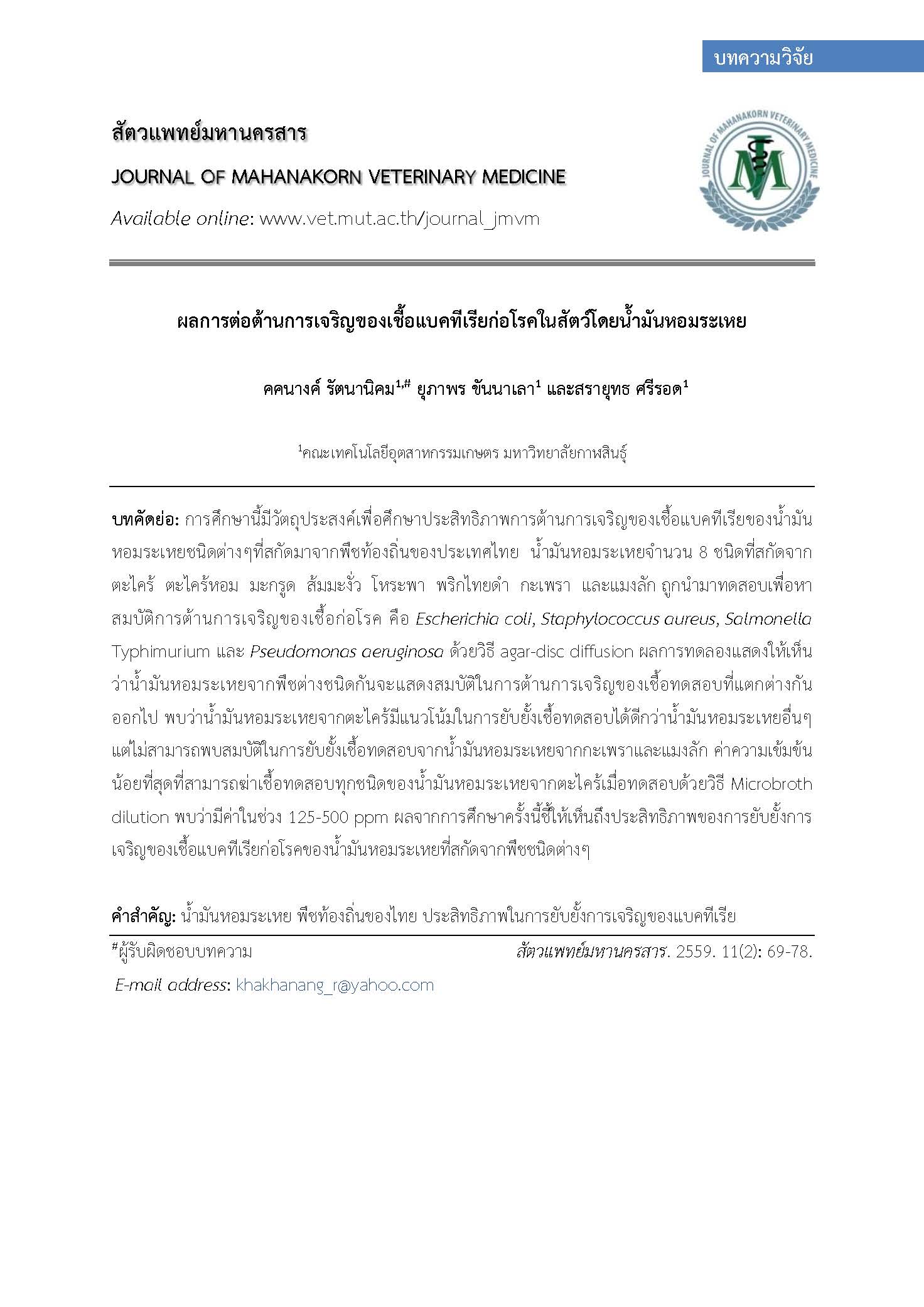Antimicrobial Effect against Animal Pathogenic Bacteria by Essential Oils
Main Article Content
Abstract
The objective of this study was to investigate the antimicrobial effect of essential oils from local Thai plants. Eight essential oils of Cymbopogon citratus Stapf. (Lemongrass), Cymbopogon nardus Rendle (Citronella grass), Citrus hystrix DC. (Leech lime), Citrus medica Linn (Citron), Ocimum basilicum L. (Sweet basil), Piper nigrum L. (Black pepper), Ocimum sanctum L. (Holy basil) and Ocimum basilicum L.f. var citratum Back (Hairy basil) were evaluated for their antimicrobial properties by agar-disc diffusion technique against pathogenic bacteria, including Escherichia coli, Staphylococcus aureus, Salmonella Typhimurium and Pseudomonas aeruginosa. The results showed that various degrees of antibacterial activity were found from different essential oils. The essential oil from Cymbopogon citratus Stapf. showed higher tendency to inhibit tested pathogens when compared with other essential oils used in this study. However, the inhibitory effects of essential oils from Ocimum sanctum L. and Ocimum basilicum L.f. var citratum Back were not observed. Minimum Bactericidal Concentration (MBC) of Cymbopogon citratus Stapf. essential oil by microbroth dilution test was ranged between 125-500 ppm for all tested pathogenic bacteria. The results showed the antimicrobial activities of essential oils from different plants against pathogenic bacteria.
Article Details
References
Celikel, N. and Kavas, G. 2008. Antimicrobial properties of some essential oil against some pathogenic microorganisms. Czech J. Food Sci. 26: 174-181.
Clark, A.M., El-Feraly, F.S. and Li, W.S. 1981. Antimicrobial activity of phenolic constituents of Magnolia grandiflora L.. J. Pharm. Sci. 70: 951-952.
Fichi, G., Flamini, G., Giovannelli, F., Otranto, D. and Perrucci, S. 2007. Efficiency of an essential oil of Eugenia caryophyllata against Psoroptes cuniculi. Exp. Parasitol. 115: 168-172.
Hammer, K.A., Carson, C.F., and Rilley, T.V. 1999. Antimicrobial activity of essential oils and other plant extract. J. Appl. Microbiol. 86: 985-990.
Hong, J.C., Steiner, T., Aufy, A. and Lien, T.F. 2012. Effects of supplemental essential oil on growth performance, lipid metabolites and immunity, intestinal characteristics, microbiota and carcass traits in broilers. Livest. Sci. 144: 253-262.
Jarriyawattanachaikul, W., Chaveerach P. and Chokesajjawatee N. 2016. Antimicrobial activity of Thai-herbal plants against food-borne pathogens E. coli, S. aureus and C. jejuni. Agric. Agric. Sci. Procedia. 11: 20-24.
Kamazen, T.A., Samah, O.A., Taher, M., Susanti, D. and Qarelleh, H. 2012. Antimicrobial activity and essential oils of Curcuma aeruginosa, Curcuma manga and Zingiber cassumunas from Malaysia. Asian Pac. J. Trop. Med. 1: 202-209.
Katiki, L.M., Chagas, A.C.S., Takahira, R.K., Juliani, H.R., Ferreira, J.F.S. and Amarante, A.F.T. 2012. Evaluation of Cymbopodon schoenanthus essential oil in lambs experimentally infected with Haemonchus contortus. Vet. Parasitol. 186: 312-318.
Miski, M., Ulubelen, A., Johansson, C. and Mabry, T.J. 1983. Antimicrobial activity studies of flavonoids from Salvia palaestina. J. Nat. Prod. 46: 874-875.
Oussalah, M., Caillet, S., Saucier, L. and Lacroix, M. 2007. Inhibitory effects of selected plant essential oils on the growth of four pathogenic bacteria: E. coli O157:H7, Salmonella Typhimurium, Staphylococcus aureus and Listeria monocytogenes. Food Control. 18: 414-420.
Rahman, M., Kuhn, I., Rahman, M., Olsson-Liljequist, B. and Mollby, R. 2004. Evaluation of a scanner-assisted colorimetric MIC method for susceptibility testing of gram-negative fermentative bacteria. Appl. Environ. Microbiol. 70: 2398-2403.
Rios, J.L., Recio, M.C. and Villar, A. 1988. Screening methods of natural products with antimicrobial activity: a review of the literature. J. Ethnopharmacol. 23: 127-129.
Singh,T.U., Kumar, D., Tandan, S.K. and Mishra, S.K. 2009. Inhibitory effect of essential oils of Allium sativum and Piper longum on spontaneous muscular activity of liver fluke, Fasciola gigantica. Exp. Parasitol. 123: 302-308.
Suwanpugdee, A., Saisornthip, R. and Sutthimusik, S. 2012. The inhibitory efficiency of the essential oil from lemon grass and citronella grass on the growth of Bovine mastitis pathogens: Staphylococcus aureus, Streptococcus agalactiae and Escherichia coli. Khonkean Agr. J. 40: 230-235.
Talbert, R. and Wall, R. 2012. Toxicity of essential and non-essential oils against the chewing louse, Bovicola (Werneckiella) ocellatus. Res. Vet. Sci. 93: 831-835.
Yousef, R.T. and Tawil, G.G. 1980. Antimicrobial activity of volatile oils. Phramazie. 35: 4-11.


